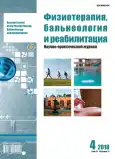Balneotherapy and physiotherapy in treatment of cognitive and psychoemotional disorders in patients with chronic cerebral ischemia
- Authors: Cherevaschenko L.A.1, Serebryakov A.A.2, Kulikov N.N.1, Tereshin A.T.1, Cherevashchenko I.A.1
-
Affiliations:
- Pyatigorsk State Scientific Research Institute of Resort Study
- Clinical City Hospital № 1
- Issue: Vol 17, No 4 (2018)
- Pages: 178-184
- Section: Original studies
- URL: https://journals.rcsi.science/1681-3456/article/view/33844
- DOI: https://doi.org/10.18821/1681-3456-2018-17-4-178-184
- ID: 33844
Cite item
Full Text
Abstract
Background. Chronic cerebral ischemia, or discirculatory encephalopathy, is one of the most common neurological diagnosis in Russia. This condition is defined as a chronic, progressive, non-stroke-related vascular lesion of the brain, which is manifested predominantly by cognitive impairment. Therapeutic measures for cognitive impairment include, first of all, the prevention of acute cerebrovascular accidents and chronic vascular cerebral insufficiency. The development and implementation of highly effective non-drug treatment methods, having few side effects, is an urgent problem in contemporary medicine. Such treatment methods can include balneotherapy and physiotherapy.
Aim: to justify the possibility and expediency of applying at the health resort treatment stage the combined use of iodine-bromine baths and a pulsed low-frequency electrostatic field in patients with chronic cerebral ischemia in order to correct cognitive and psychoemotional disorders and improve the quality of life.
Methods. The study included 90 patients with chronic cerebral ischemia, who were randomly divided into 3 treatment groups. The control group patients received iodine-bromine baths, the comparison group patients received exposure to an alternating pulsed low-frequency electrostatic field using the HIVAMAT-200 apparatus, and the main group patients received iodine-bromine baths and exposure to a pulsed low-frequency electrostatic field. The cognitive and emotional-volitional sphere was studied using standard neuropsychological techniques, namely the minimum cognitive deficit scale Mini Mental State Examination (MMSE); Luria’s test, the Clock Drawing test, Schulte tables, and Yu.L. Hanin’s anxiety scales. The study of quality of life was performed using the Russian version of the general questionnaire MOS SF 36 Iterm Short-Form Health Survey.
Results. It has been proved that as a result of treatment, disorders of memory and attention are reduced, the general cognitive status of patients is improved, which slows down the disease progression, reduces the risk of vascular catastrophes and dementia.
Conclusion. New medical technologies developed for the treatment of patients with chronic cerebral ischemia at the health resort treatment stage are highly effective, pathogenetically substantiated, and can be recommended for widespread use in a network of health resort institutions and rehabilitation and preventive institutions of practical health care.
Full Text
##article.viewOnOriginalSite##About the authors
Lyubov A. Cherevaschenko
Pyatigorsk State Scientific Research Institute of Resort Study
Author for correspondence.
Email: elenasoboleva2005@yandex.ru
ORCID iD: 0000-0001-9246-5582
SPIN-code: 5520-9799
д.м.н., профессор
Russian Federation, PyatigorskArtem A. Serebryakov
Clinical City Hospital № 1
Email: elenasoboleva2005@yandex.ru
ORCID iD: 0000-0002-5271-5062
Russian Federation, Krasnodar
Nikolay N. Kulikov
Pyatigorsk State Scientific Research Institute of Resort Study
Email: elenasoboleva2005@yandex.ru
ORCID iD: 0000-0001-7105-1268
SPIN-code: 9022-1846
MD, PhD
Russian Federation, PyatigorskAnatolii T. Tereshin
Pyatigorsk State Scientific Research Institute of Resort Study
Email: elenasoboleva2005@yandex.ru
ORCID iD: 0000-0002-3034-9479
SPIN-code: 5939-1461
MD, PhD, Professor
Russian Federation, PyatigorskIgor A. Cherevashchenko
Pyatigorsk State Scientific Research Institute of Resort Study
Email: elenasoboleva2005@yandex.ru
SPIN-code: 6237-7967
MD, PhD
Russian Federation, PyatigorskReferences
- Кадыков А.С., Манвелов Л.С., Шахпаронова Н.В. Хронические сосудистые заболевания головного мозга. Дисциркуляторная энцефалопатия. М.: ГЭОТАР-Медиа; 2018.
- Камчатнов П.Р., Чугунов А.В. Хронические цереброваскулярные заболевания. Доктор.Ру. 2017; (1): 11-15.
- Дамулина А.И., Кадыков А.С. Когнитивные нарушения при хронической ишемии головного мозга. Фарматека. 2014; (10): 55-61.
- Парфенов В.А., Неверовский Д.В. Ведение пациентов с дисциркуляторной энцефалопатией в амбулаторной практике. Неврология, нейропсихиатрия, психосоматика. 2015; (1): 37-42.
- Епифанов В.А., Епифанов А.В., Котенко К.В., Корчажкина Н.Б. Реабилитация при заболеваниях и повреждениях нервной системы. Москва, 2016. 656 с.
- Турова Е.А., Фадеева Н.И., Балабан Е.И., Головач А.В. Оценка влияния импульсного низкочастотного электростатического поля на психоэмоциональный статус и когнитивные способности у лиц старше 30 лет. Психическое здоровье. 2013; (2): 50-53.
- Ганюта А.В. Хивамат-терапия. В кн.: Молодежь в науке. Новые аргументы. Сб. научных работ III Международной молодежной научной конференции. Липецк; 2017: 135-137.
- Череващенко Л.А., Дадова Л.Ю., Куликов Н.Н., Череващенко И.А. Озонотерапия и йодобромные ванны в коррекции когнитивных нарушений у больных хронической ишемией головного мозга. Курортная медицина. 2016; (4): 36-41.
- Hansfeld S., Roberts R., Foot S. Assessing the validity of the SF-36 General Health Surveg. Qual Life Res. 1997; (3): 217-224
- Шмидт Е.В. Классификация сосудистых поражений головного и спинного мозга. Журнал невропатологии и психиатрии. 1985; (9): 1281-1288.
- Яхно Н.Н., Локшина А.Б., Захаров В.В. Синдром умеренных когнитивных расстройств при дисциркуляторной энцефалопатии. Журн. невропатол. психиатр. 2005; (2): 13-20.
- Локшина А.Б., Захаров В.В. Вопросы терапии хронической ишемии головного мозга. Эффективная фармакотерапия. 2017; (31): 48-55.
- Лурия А.Р. Высшие корковые функции человека и их нарушения при локальных поражениях мозга. М.: Изд-во МГУ. 1969.
Supplementary files






